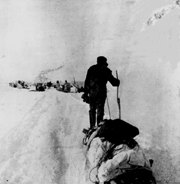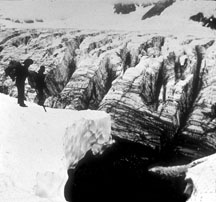
For most of the two thousand people landing in April, Valdez was little more than a way station, a place to unload and temporarily cache their outfits before beginning the arduous haul over the glacier. Let us for now go along with the crowd and follow those 3,000 intrepid yet foolish souls who would defy death and danger to follow their dreams of instant wealth over the Valdez Glacier into the unknown. . . .

"Well I have now learned what it is to make an ass of myself in earnest, one way at least, is to harness yourself up to a six foot sled, put 200 pounds on it and strike the trail for the foot of the glacier which is five miles away. Repeat this twice a day for a week and you soon have long ears . " (Hazelet, Diary, p. 31, May 17/98).
Photo of Camp Valdes by Neal Benedict a member of Margeson's party. From the Messer Collection courtesy of the Cook Inlet Historical Society.
Before leaving "Camp Valdez," each person must load his hand sled for the 5 mile trudge to the foot of the glacier. Joe Bourke describes the typical Yukon sled used along the Valdez trail.
Our sleds: these are the most important articles we possess, for without them we could not move. We purchased them in Seattle for Six dollars each. They are of tough wood, strongly built and quite light for their size, being Seven feet long by Eighteen inches wide and Eight inches high. They are in skeleton form having Five slats for a top. They will bear a weight of at least Fifteen hundred pounds . . . .Our sleds served us well in the day time for carrying our loads and at night they did elegant service as bedsteads on which we placed our sleeping bags and we were thus kept up from the snow flooring of our tent. . . . (Bourke, p.8)
On the right hand side of each sled projected a 6 foot "gee pole" for steering; the pole projected upward and forward. The sleds could either be pushed from behind or pulled from ahead. Although Bourke remarks that sleds could bear 1500 pounds, they were never loaded that heavily. The steepness of the slope usually determined the weight carried. The average load was around 150 pounds. On a downhill run as much as 1000 pounds might be transported; whereas on a steep ascent less than 100 pounds was considered a load. Since the incline to the foot of the glacier was only 300 feet in a little over five miles, the sleds might be loaded with anywhere from 200 to 350 pounds.
For crossing the glacier and a summer's prospecting, each man required from 1500 to 2000 pounds of supplies consisting of heavy tarpaulin tents, a sheet metal Yukon stove for cooking and warmth (some carried oil stoves for the glacier), a heavy sleeping bag, oil skins, extra boots, and lots of wool clothing, cooking utensils, axes and a whipsaw for boat building. Food consisted mainly of hard tack, beans, bacon, flour, rice, and occasionally powdered eggs, potatoes, and dried fruit. These he would load aboard his sled in appropriately sized bundles and begin trudging back and forth to the foot of the glacier. . . .
Although the slope was not steep, a quick calculation reveals that this was not an easy task - especially through newly fallen or slushy melting snow. Fifteen hundred pounds in two hundred pound loads would require at least seven trips back and forth to the terminus of the glacier; this would require trudging through snow some seventy miles - half of them pulling a 200 pound sled. And this was only the beginning; once the foot of the glacier was reached, this performance would be repeated for another three hundred and sixty miles while gaining almost a mile in elevation. Even though a lightly loaded man might make the summit in two days, when the frequent storms on the glacier are factored in, it took many parties from six weeks to two months to lug their supplies across this formidable ice barrier. As R. F. McClellan put it, "this was something like work (Holeski, p. 308)." Guiteau observes, this prospect was too much to contemplate for some: "Every day we hear of some fellow we used to meet going and coming on the trail that has backed out and is offering his outfit for sale (Guiteau, Diary, 3/11/98, p.4)."
Gold seekers from warmer climes traveling back and forth on the trail were soon to learn that winter and cold were their friends and that those arriving earliest in the spring were to have the easiest time crossing the glacier. When the weather was clear, crisp, and cold, a good crust formed on the deep snow making sledding easy; but during warmer periods, usually accompanied by heavy, wet spring snow or even rain, the trail became slushy and soft. Men and sleds would break through the crust or sink deeply into the soft snow. At these times, traveling at night when it was colder was the only solution. Later, when the spring rains began, many sections of the trail flooded; the glacier stream overflowed it banks, and small lakes formed at the terminus of the glacier. Later still, when the snow disappeared completely, it was almost impossible to transport the heavy supplies from the shore to the foot of the glacier without pack animals.
During winter and early spring, the glacier's many crevasses were filled with deep snow forming reliable snow bridges. But when the snow began to melt, many crevassed areas become impassable; and the snow-covered surface of the glacier was transformed into slippery glare-ice.

"There were a few deep crevasses still open, but the trail naturally avoided them. Doubtless we passed over many that were bridged with snow, but we gave the matter little thought. The whole thing was awesome (Austin, p. 27.)
Photo of Camp Valdes by Neal Benedict a member of Margeson's party. From the Messer Collection courtesy of the Cook Inlet Historical Society.
Although the constant trips to and fro fetching supplies could be monotonous and boring, there was still time for a man to reflect upon the natural beauty of his surroundings. Joe Bourke describes the trip to the glacier:
Here nature presents itself in all its grandeur. We are traveling through a valley of an average width of probably Two miles. This is closed in on both sides by towering mountains covered with snow which frequently slides down into the valley causing a great noise in its descent (Bourke, Diary, p. 10).
George Hazelet was as much impressed by the human drama being played out on the glacier as by its natural beauty:
The glacier is a wonderful thing. It begins almost at the edge of the sound at the time of year we reached it. And it extends in generally a northern direction for about 15 miles to its summit where it reaches a height of 5140 feet as indicated by our barometer, and crosses over the range it runs down on the north slope of the coast range for a distance of about 10 miles. . . . The man that starts in to pull 1500 lbs of supplies from Valdez to the top of the summit must needs have plenty of grit, a good supply of muscle, for it is no easy task and I firmly believe that many of the parties now put down at Valdez alone to overcome this task would fail, but seeing others going over, with determination set in every line of their faces, they brace up and proceed and finally to their surprise almost, they have accomplished what under other circumstances would have proven impossible (Hazelet, Diary, 5/1/98).
Basil Austin describes the approach to the terminus of the glacier:
As we obliquely approached the glacier, it surely looked like an impassable wall of ice, rugged and in most places almost perpendicular. Its face, hundreds of feet in height, exposed blue ice by the millions of tons, while snow covered and banked up on every place that was not too vertical for it to cling to. We could not see over it, but snow was drifting in whisps and swirls on the rim, although it was a clear day with no wind on the flat below (Austin, p. 23).
(From Chapter 4, pp. 39-42.)